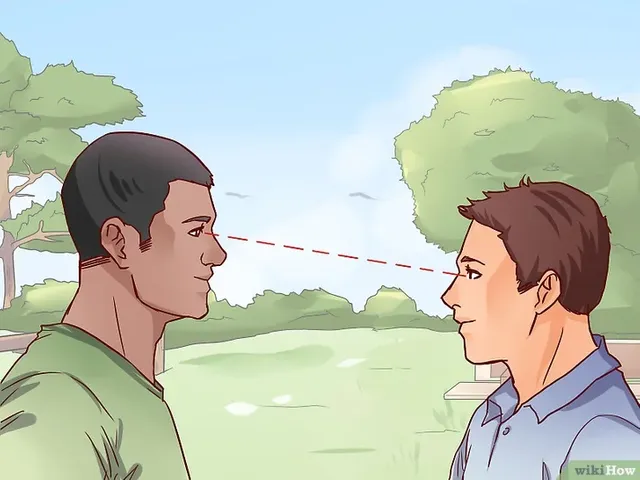How To Introduce Yourself Properly
n practice, introducing yourself is more than just a name. Introduction is a way to connect with new people through word exchange and sometimes physical contact. Introducing yourself to a stranger is complicated because what you say depends entirely on the context. You can introduce yourself in different ways depending on who you are dealing with, whether a group of audiences before you give a speech, meet someone at a social event, or just start a conversation with a new person at a party. The most important factor is to introduce yourself in a proper way and to make people like and remember you.
1. Introducing Self in Social Situation

Make eye contact
Eye contact indicates that you are fully engaged in an interaction. Eye contact is one way to connect with others and show that he gets your attention. If you make eye contact, it shows that you are open and fully involved.
- If you are uncomfortable looking at someone directly into his eyes, look at the point between his eyebrows, he will not notice the difference.
- If you are in a group, occasionally make eye contact with them all.

Smile.
Bright and sincere smile is important when meeting new people. Show genuine pleasure when meeting new people and try to share positive experiences, it will help create a genuine smile. To create a smile that is more sincere and not made-up, you need to involve the upper face when smiling.
Show proper body language.
the body must convey that you are confident and relaxed. Stand with your head upright and your back pulled back, be careful not to bend over. Draw the body language of the people around you. They also imitate their speed and tone to create harmony.
2. Introducing Self to Individuals

Mention each name
In formal introductions, say "Hello, I [first name] [last name]." If it is not formal, say, "Hi, I [first name]." Immediately after saying your name, ask the other person's name by saying "Your Name ? "In a pleasant tone. After knowing his name, repeat by saying "Glad to meet you, Wakrau" or "Nice to meet you, Karin."
- Repeating a name will help you remember the person and put a personal touch into the introduction.

Handshake or use other culturally appropriate language.
Most cultures have a form of physical contact that accompanies greetings. In Indonesia people usually shake hands when meeting. Make sure your handshake is short and not too weak or strong.
- Be aware of cultural differences. For example, shaking hands firmly in China is considered rude.
- Meeting someone with a cuddle is also considered appropriate, especially if you meet friends of a friend or sister-in-law. When compared with handshakes, more hugs show openness. Women usually prefer to hug rather than shake hands like men.
- In many cultures, kissing the cheeks when meeting is also considered appropriate. For example, in South America all women are welcomed with kisses, and in France women are greeted with kisses on the left and right cheeks. If you're not sure which to use, follow other people's examples or how those around you greet.

Ask questions
In introductions, it is important to show interest in others. Ask the origin, what work, or equations you might have. Ask him what activities he likes to do and his interests. Show that you are interested and interested in what he says.
- You can tell a little background to continue the conversation and share about yourself. For example, telling the workplace or hobby of rock climbing that you like will be appropriate in introductions and may lead to more topics.
- Do not take the opportunity to just talk about yourself. You will seem selfish or uninterested.

Close the conversation
After meeting someone for the first time, you need to end the conversation by stating again that you enjoyed the meeting. If the interaction is formal, say "Mrs. Sastro, I am glad to see you. I hope we can talk again next time. "If the nature of the conversation is not formal, you can say" Nice to meet you, Hari. I hope we can meet again. "
3. Introducing Yourself Before Speech

Welcome your audience and say your name
Mentioning first and last name is important when giving a speech. When greeting and mentioning names, remember to speak clearly and confidently.

Provide some relevant information about yourself
After saying the name, tell me your relevance with the speech to ensure credibility. The type of information you share depends on the audience and the subject you are talking about. If you give a speech on the importance of eating organic food, say that you are a scientist, a chef, or an environmentalist. If you give a speech about child development, make sure you include information that you are a child psychologist.
- Please provide other relevant information. For example, you can provide a brief background on your credible experience. "My name is Erika Larasati and I am a lecturer in Environmental Science at Gadjah Mada University. After doing research in the Borneo rain forest, I realized the importance of sharing ways of protecting the environment. "

Communicate effectively
From the very beginning, make sure your voice is loud enough for everyone who listens. Avoid mumbling sounds by pronouncing consonants as clearly as possible. You can even ask the audience if your voice is loud enough to be heard by everyone. Audiences will not be able to understand or appreciate the information you provide if they can not hear you.

Move your body
Stand with good posture and move freely when speaking. Stand up straight, pull your shoulders back so you do not bend over, and free your hands and move them when needed. If you do not stand behind the podium, walk around the stage to show the audience that you are comfortable and not stiffly berpostur.
4. Introducing Self in Professional Events

Please provide your full name
Make sure you provide your full name so that the other person can remember your name. You can say, "Hi, my name is Mark Salim" or "Hello, I'm Anita Gendis". In this way, they tend to remember you.

Give a one-sentence description of your work
If you are on a social networking event, chances are you will talk about work with many people. So what do you say when a connection asks, "What is your job?" Are you going to start spending 10 minutes telling you about your career journey? Will you name your list of achievements one at a time? Of course not. If you are not engaged in a long conversation, you should be prepared to provide a job description in one sentence that contains the following information :
- Who are you, professionally? Are you a teacher, project manager, or health professional?
- Who do you work with? Do you work with children, intercultural project teams, or microfinance organizations?
- What are you doing? Are you helping second graders developing their writing skills, do you help intercultural teams meet their goals while overseeing their budgets, or do you help microfinance organizations develop a market base in developing countries?
- Now, unite the sentence of the answer. State who you are, with whom you work, and what you do.

Appreciate someone else's space
If you carry goods, do not place them on the recruiter's desk or presenter. Appreciate their space and do not overload it. You can also interfere with their material, such as knocking out posters or damaging pamphlets. Wait until prompted before giving business cards, work resumes, and more.

Follow up with questions
If the first person talks about your job, do not just walk away or praise yourself for a well-done job. Instead, ask what the other person's job is. It's not only polite, but it shows that you have a genuine interest in his career journey and really want to build a connection.

Say goodbye like a professional
Do not just wave and say, "See you again" and stay away. Anyone you meet at a social networking event may have the potential to help you in the future, so make sure you make eye contact, repeat the name, and exchange business cards or other relevant information before parting.
Tips :
- Keep your focus on the people you meet, give them the respect you want to receive.
- Avoid any food that may stick in your teeth.
- Do not look in the other direction or behave as if you are disturbed, it will make you look bored or uninterested.
- Do not talk when your mouth is full of food.
- Focus on the positives. Introduction is not the time to say negative things about yourself or others.
- Try to ease the atmosphere with a joke or praise.
- If your hands tend to sweat, wipe with a handkerchief before starting to get acquainted.
Source:https://id.wikihow.com
✅ @wakrausablon, I gave you an upvote on your first post! Please give me a follow and I will give you a follow in return!
Please also take a moment to read this post regarding bad behavior on Steemit.
thanks for upvote me @introduce.bote